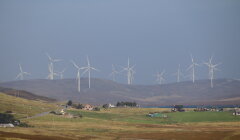Energy / Tory MPs call for discounted energy bills for households near future onshore wind farms
AN INFLUENTIAL committee of Conservative MPs has recommended that people living close to wind farms in the future should receive free or discounted energy.
The 1922 Committee has also backed the idea of local referendums for future onshore wind farm developments.
It comes amid a continued push from Shetland Islands Council to governments for the consideration of a special ‘tariff’ for the isles, which will play host to the major Viking Energy onshore wind development.
Meanwhile the Scottish Government this week published a route map to “secure Scotland’s fastest possible fair and just transition away from fossil fuels”.
The draft ‘Energy Strategy and Just Transition Plan’ sets out a plan for Scotland’s renewables revolution to be accelerated as North Sea basin resources decline.
One proposal includes setting out final policy positions on fossil fuel energy, including consulting on a “presumption against new exploration for North Sea oil and gas”.
However oil and gas exploration is a reserved matter for the Westminster government.
There is also a push for additional 20GW of renewable electricity generation capacity in Scotland by 2030.
The 1922 Committee – which features all Tory backbench MPs in the House of Commons – recently published its own report on energy market reform in the UK.
Committee chair Andrea Leadsom said: “Our overriding conclusion is that urgent government action is needed, both on promoting domestic energy generation and on facilitating energy demand reduction.”
But a key feature of the report is around local communities living near onshore wind farms.
It suggests that all households within one mile of proposed wind farms should receive a 100 per cent discount on energy bills during the lifetime of the development.
The committee recommends that drops to 50 per cent for houses within three miles and 25 per cent for households in a four mile radius.
Become a member of Shetland News
“By linking the payments to distance, this will encourage developers to avoid sites directly adjacent to communities, reducing disruption and visual damage,” the report said.
In Scotland planning is a devolved matter, as are some aspects of energy.
Climate and energy expert Richard Black, however, said on Twitter that “insisting that people should be compensated financially for living near a wind farm promotes the idea that wind farms present a serious ongoing disruption, and that people are generally opposed” – which he said are both untrue.
He also questioned the people who live next to power stations, for instance.
The 1922 Committee also backed the idea of all proposed onshore wind and solar farms, and fracking projects, be subject to local referendums.
There is also a call for Ofgem to explore local electricity pricing on the market to reflect how supply and demand varies across the country in different weather conditions.
Shetland’s central mainland is currently seeing the construction of the 103-turbine Viking Energy wind farm, which has proved controversial in years gone by over its impact on the local environment, its size and level of community payback.
The developer, SSE, has pledged community benefit payments worth up to £2.2 million a year once it is up and running in 2024, but in the early stages of the project there were hopes for greater payback.
Meanwhile the push for a ‘Shetland tariff’ comes as the isles experience high levels of fuel poverty.
The argument is that Shetland residents should enjoy cheaper energy because of having a large exporter of energy like Viking Energy on their doorstep.
The developer says the wind farm could provide “enough electricity to meet the needs of up to 475,098 homes”.
The increasing prospect of offshore wind developments in the waters around Shetland have also intensified calls around community benefit.
A recently approved set of developer principles created by Shetland Islands Council suggests that offshore wind developments could potentially offer community benefit through electricity itself rather than cash.
Shetland has one proposed onshore wind farm which does not yet have planning consent – the 18-turbine Energy Isles project in Yell, which is under consideration by Scottish ministers as it would be over 50MW in capacity.
The 17-turbine Beaw Field wind farm in the south of Yell, and Mossy Hill – which would see 12 turbines located on the outskirts of Lerwick – already have planning approval.
The Scottish Government’s new draft Energy Strategy and Just Transition Plan gives reference to the ORION project, which aims to facilitate Shetland becoming a clean energy island.
There is also reference to a commitment from the Scottish Government to invest £9 million in the development of an ultra-deep-water port at Dales Voe in Lerwick to boost Scotland’s decommissioning industry.
Some North Sea infrastructure, like the Ninian Northern platform, have already been decommissioned at Dales Voe but making the port deeper would enable the Lerwick Port Authority facility to bid for more jobs.
However the energy plan urges the UK Government to provide more support directly to the decommissioning sector.
Scottish just transition minister Richard Lochhead said: “The oil and gas industry has made a vast contribution to Scotland’s economy and its workers are some of the most highly-skilled in the world. But Scotland’s oil and gas basin is now a mature resource.
“A just transition to a net zero energy system will secure alternative employment and economic opportunities for those already working in the industry and will provide new green jobs in Scotland for future generations.”
Environmental campaign group Friends of the Earth Scotland, however, claimed there was “very little” in the way of new measures to tackle the climate emergency or the immediate impacts of the cost of energy crisis.
Head of campaigns Mary Church said: “After two years of preparation, this is a document chock full of existing commitments that we already know are insufficient to meet our climate targets, never mind the surge in action we need to see this decade.”
Become a member of Shetland News
Shetland News is asking its many readers to consider paying for membership to get additional features and services: -
- Remove non-local ads;
- Bookmark posts to read later;
- Exclusive curated weekly newsletter;
- Hide membership messages;
- Comments open for discussion.
If you appreciate what we do and feel strongly about impartial local journalism, then please become a member of Shetland News by either making a single payment, or setting up a monthly, quarterly or yearly subscription.

















































































